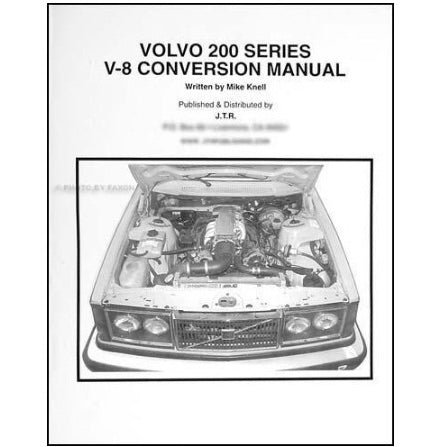Office
V-8 Conversion Manual for Volvo 200 Series
V-8 Conversion Manual for Volvo 200 Series
Couldn't load pickup availability
|
Overview: 120 page illustrated guide written by Mike Knell shows how to install the small block Chevrolet V-8 into 1975-1993 Volvo 240 and 260 models. See the excerpt from the introduction below. What it Covers: The book includes dimensioned illustrations of the motor mounts and instruction on tachometer calibration. Covers stick shift and automatic transmissions. * * *
Excerpt from the Introduction. We purchased a diesel Volvo with the sole interest of installing a V-8 for this conversion manual. Our goal was to do an engine swap that was repeatable and functional. The parts for the swap had to be easy to make and/or readily available. And we didn't want to change the feel of the car. This Volvo originally had a diesel engine and an automatic transmission. It had about 110,000 miles and the engine was worn out and would not start in cold weather. The Volvo diesel engine was actually built by Volkswagen and was never noted for its durability. The nice part about the converted car is that it needed virtually no modification aside from the new engine. The diesel Volvo has the advantages of coming with suspension and brake components that are compatible with the V-8 because the diesel engine is fairly heavy. Some disadvantages of installing the engine were that the fuel system and the exhaust system (which includes heat shields) have to be changed for the gas engine. The electrical system is also a bit more work to hook up, compared to conversions of a gas car. As you can see in the above photo, the V-8 installation looks nearly stock. The engine is a 305 throttle-body-injected V-8 from a 1991 Camaro. Almost all of the parts are available from Volvo or Chevrolet. This is what makes the engine swap so repeatable, and so stock looking. In this photo, the battery had been relocated to the passenger's side to improve balance, and to allow using the battery cables that came with the 1991 Camaro engine. Later, the battery was moved to the trunk to improve front/rear weight distribution. The windshield washer reservoir and the coolant recovery tank were relocated to where they fit best. The air conditioning hoses were also re-routed. The firewall required no hammering, but the transmission tunnel needed lots of hammering to accommodate the 700-R4 transmission. The V-8 did add some weight to the car. With all options (air conditioning, power windows, sunroof), 700-R4 automatic transmission, heavy-duty trailer hitch (about 35 lbs), full tank of gas, rear mounted battery, IPD swaybars (about 15 lbs heavier than stock), and 2-1/2" exhaust; the car weighs about 3325 lbs and the weight distribution is 56/44 (front/rear). The published curb weight for the Volvo is listed at about 3120 lbs. Taking into account that the sway bars and trailer hitch added about 50 lbs, the V-8 added about 150 lbs. The weight distribution is close to stock, and it is much better than the late-model V-8 Mustangs and Camaros which typically have a weight distribution of 58/42. The car has a heavier feel than a 4-cylinder car, but it does not feel much different than a diesel car or a V6 car. It doesn't even feel very fast, although it accelerates quite well. That phenomenon is referred to as refinement. A quiet, smooth car typically feels slower than it really is. Conversely, a noisy, vibrating car often feels faster than it really is. Improved Merging Power! With the standard 3.31 gears, 195/70-14 tires, a 700-R4 transmission, and the stock Volvo 2 inch diesel exhaust, the car would do 0-60 mph in 8.1 seconds. The 1/4 mile took about 16.3 seconds with a trap speed of 84 mph. Changing to a 2-1/2" exhaust improved the 0-60 time to 7.7 seconds. The 1/4 mile took 16.1 seconds with a trap speed of 86 mph. These are real numbers, not hyped up numbers used for magazine articles or advertising purposes. In overdrive (.70:1), engine speed was 1900 rpm at 60 mph. Driven conservatively, gas mileage averaged about 18 mpg with either exhaust, trip mileage (freeway travel at 65-70 mph) was about 22 mpg. A Borg-Warner 5-speed transmission with a .63:1 overdrive was then installed. A lightweight flywheel (16 lbs) from a TPI Camaro was installed to reduce weight, making for a weight about 70 lbs less than with the automatic transmission. Although the car felt much quicker, 0-60 mph takes 4/10 seconds longer (about 8.1 seconds) because it takes about 1/2 second to shift from one gear to another, and two gear changes are required to get to 60 mph. The quarter-mile takes 16.2 seconds with a trap speed of 87 mph. In fifth gear (.63:1), engine speed is 1700 rpm at 60 mph. Driven conservatively, gas mileage averages about 19 mpg, and trip mileage is about 24 mpg, which is not surprising considering this same engine and transmission in a 1991 Camaro is EPA rated at about 17 mpg city and 26 mpg highway, although the Camaro has taller tires (26" diameter) and a taller rear axle ratio (2.73). Depending on which magazines you believe, the performance and fuel mileage is comparable or superior to a Turbo-Intercooled 240 Volvo. We installed a NOS (Nitrous Oxide Systems) throttle-body nitrous system to see how the car would hold up with some real power. The car has run a best quarter mile in 14.8 seconds at 95 mph with no mechanical problems. These times are very close to that of the 1994 Camaro Z28 with the 275 horsepower LT1 engine. It would be very expensive to get a Volvo engine to put out that kind of power. To really test the V-8 swap, the author used this car to teach his sixteen-year-old nephew how to drive a stick shift. The car came through just fine, but the author required some additional visits to his therapist. |
Share



